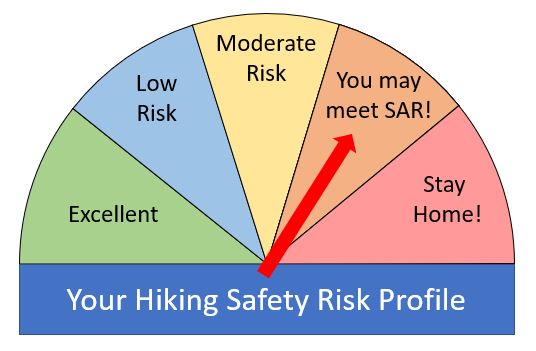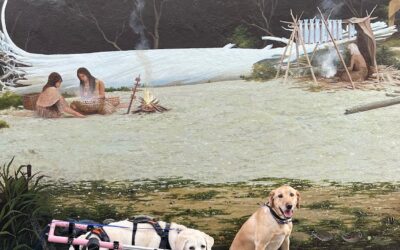Most hikers don’t realize it, but when they head out on the trail or into the wilderness, they carry with them a Risk Profile.
In 2018, a novice snowshoer perished after getting lost while descending the Muir Snowfield on Mount Rainier.
On the second day of the incident, search managers in the EOC (Emergency Operations Center) quickly assembled what was known about the lost subject.
The lost hiker’s profile
- He had started up the mountain despite a forecast for bad weather later in the day.
- He had separated from his companion at an elevation of about 8,000 feet.
- He was unfamiliar with the area and the route.
- He had no mountaineering experience.
- This was his first time on snow, and this was his first time using snowshoes.
- He carried no stove, no extra food, and no headlamp.
- He carried no map or compass.
- He carried no shelter or bivouac gear.
Glances were exchanged as we sat around the planning and operations table. What we quickly realized, but what this unfortunate person was not aware of, was that his risk profile was way toward the wrong end of the scale, even before he got lost. He was an accident waiting to happen.
When you embark on a hike, your planning, your preparation, your experience, your hiking route, your hiking style, your equipment: all of these can elevate or lower your risk profile.
The good news is that you can get a pretty good idea of where you are on the risk profile scale, just by considering a few key factors.
Your Hiking Risk Profile
What Factors Increase Your Risk?
| Risk Factor | Why This Is Important | Points |
| I hike alone | If something goes wrong, you have no backup, no one to render first aid, and no one to call for help. | -30 |
| I take selfies near cliffs | If the camera is recovered, we’ll have something to remember you by. | -20 |
| I step over railings | Every year, SAR recovers the bodies of folks who thought this was a good idea. | -20 |
| I’m a trail runner | Trail runners typically travel solo, carry inadequate clothing and gear, and can get far from the trailhead. Running around trail corners is a good way to startle bears and provoke unpleasant responses. | -10 |
| I didn’t check the weather | Bad weather can move in quickly, and if you’re lost or immobilized, can bring hypothermia and death. | -10 |
| I’m unfamiliar with the area | Translation: “I don’t know what hazards (terrain or wildlife) are important to watch out for.” | -10 |
| I don’t have map/compass skills | Increases your chance of wandering off course, getting lost, and staying lost. | -10 |
| I don’t carry a cell phone | You have no way to call for help if you get lost or injured. | -10 |
| I plan to chase bear cubs | OK, most people don’t plan to chase cubs, but staying alert on the trail will help you avoid them. | -10 |
| My dog will be off leash | Loose dogs can lead their owners into hazard terrain or into disastrous encounters with bears or cougars. | -10 |
What Factors Lower Your Risk?
| Risk Factor | Why This Is Important | Points |
| I’ll hike with companions | You’ll have someone to render aid, someone to call for help, and someone who might share their snacks. | +20 |
| I’ll research the route in advance | Guidebooks will warn you of hazards, and allow you to assess if the hike is within your capabilities. | +10 |
| I’m going to leave a hike plan | If you let someone know where you plan to go, and when you expect to be back, SAR will know when and where to look for you. | +10 |
| I’ll check the weather forecast | Knowing that the weather is good today is not enough. You need to consider forecast changes. | +10 |
| I always carry the 10 essentials | By carrying a critical core of “what if I needed this” gear, you are prepared if something goes wrong. | +10 |
| I carry a full-charge cell phone | Did you know that when you call 911, dispatchers can see your Lat/Lon coordinates and relay them to SAR? | +10 |
| I practice with map & compass | Practice “active navigation” – keeping track of where you are during your hike is a way to avoid getting lost. | +10 |
| I wear layered synthetic clothes | Cotton wicks heat from your body and contributes to hypothermia. Extra synthetic layers keep you warm. | +10 |
| I wear boots with ankle support | Twisted or broken ankles are a frequent cause of SAR rescues. | +10 |
So grab a pencil, and take a moment to assess your risk profile. Add up the negative points for factors that increase your risk. Add up the positive points for practices that reduce your risk.
This is a totally informal and unofficial profile rating system, but should give you some important things to think about.
How did you do?
- If your score was between 80-100, you’re doing a pretty good job with your risk profile.
- Think of a score between 60-80 as “OK, but you can do more to reduce your risk.”
- Scores between 40-60 certainly need attention.
- If your score is between 20-40, you may need SAR on your next hike.
- Lastly, if your score is less than 20 – well, just stay home!




0 Comments